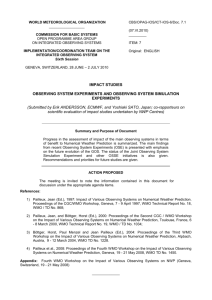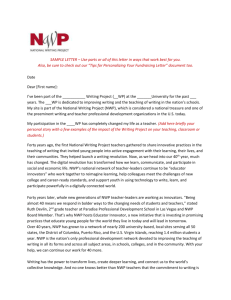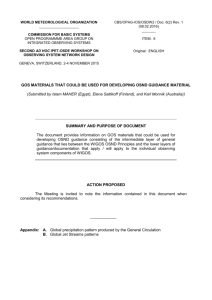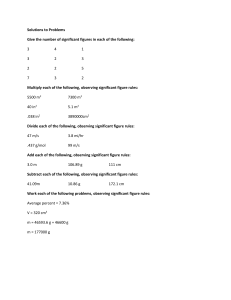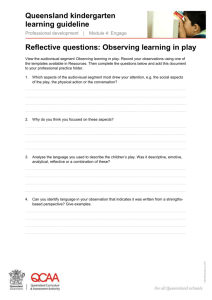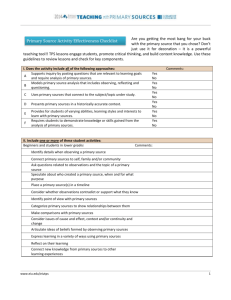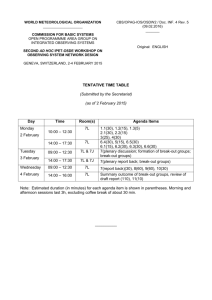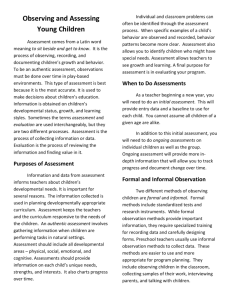Observing System Experiments and Observing System Simulation
advertisement
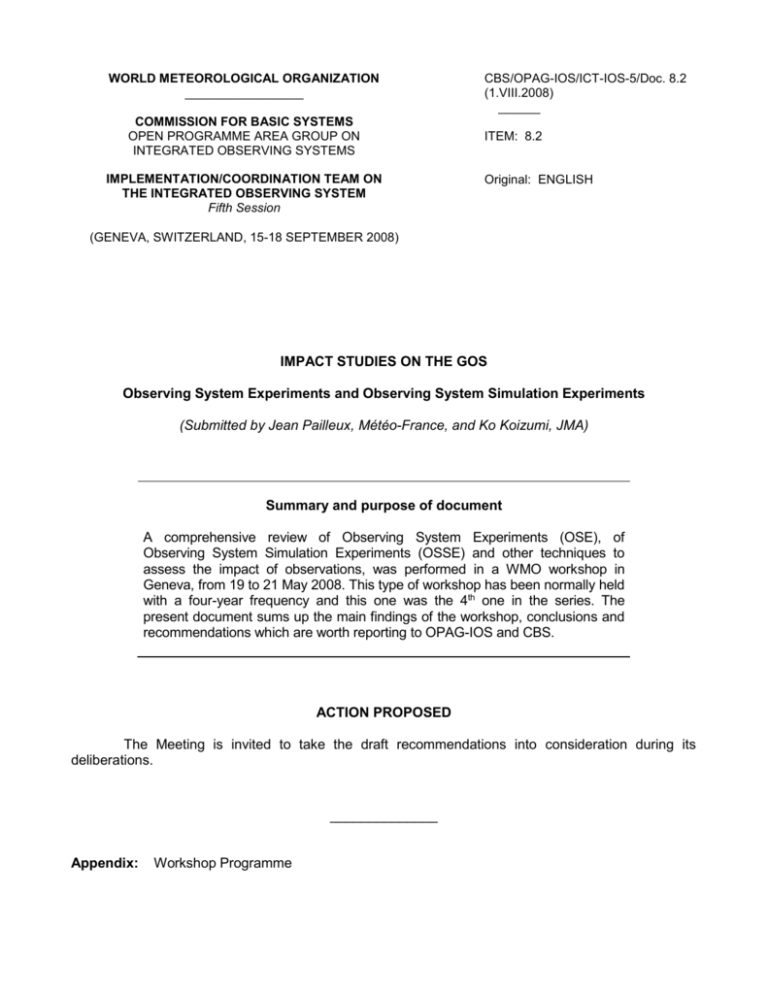
WORLD METEOROLOGICAL ORGANIZATION _________________ COMMISSION FOR BASIC SYSTEMS OPEN PROGRAMME AREA GROUP ON INTEGRATED OBSERVING SYSTEMS IMPLEMENTATION/COORDINATION TEAM ON THE INTEGRATED OBSERVING SYSTEM Fifth Session CBS/OPAG-IOS/ICT-IOS-5/Doc. 8.2 (1.VIII.2008) ______ ITEM: 8.2 Original: ENGLISH (GENEVA, SWITZERLAND, 15-18 SEPTEMBER 2008) IMPACT STUDIES ON THE GOS Observing System Experiments and Observing System Simulation Experiments (Submitted by Jean Pailleux, Météo-France, and Ko Koizumi, JMA) Summary and purpose of document A comprehensive review of Observing System Experiments (OSE), of Observing System Simulation Experiments (OSSE) and other techniques to assess the impact of observations, was performed in a WMO workshop in Geneva, from 19 to 21 May 2008. This type of workshop has been normally held with a four-year frequency and this one was the 4th one in the series. The present document sums up the main findings of the workshop, conclusions and recommendations which are worth reporting to OPAG-IOS and CBS. ACTION PROPOSED The Meeting is invited to take the draft recommendations into consideration during its deliberations. ______________ Appendix: Workshop Programme CBS/OPAG-IOS/ICT-IOS-5/Doc. 8.2, p. 2 OBSERVING SYSTEM EXPERIMENTS AND OBSERVING SYSTEM SIMULATION EXPERIMENTS Report on CBS OSE / OSSE Workshop, May 2008 and other issues concerning observing system studies 1. INTRODUCTION The fourth WMO Workshop on the Impact of Various Observing Systems on NWP was held in Geneva, Switzerland, from 19 to 21 May 2008. The Workshop was organized into four sessions, (i) global forecast impact studies (including studies with some regional aspects), (ii) regional aspects of impact studies, (iii) sensitivity, impact assessment techniques, observation network design studies, and, (iv) workshop conclusions and recommendations. The Workshop programme is reproduced as Appendix. The present report documents the main findings of the workshop (section 2) and the main conclusions and recommendations (section 3). 2. MAIN FINDINGS OF THE WORKSHOP ON IMPACT STUDIES As an important tendency of the period 2004-2008 has been the appearance of new observing systems (especially from satellites), the individual impact of most individual observing systems has decreased compared to 2004, but the total impact of the combined observing systems has improved, and the GOS is now more robust because of the variety and quality of instruments available. In the previous workshop (Alpbach – 2004), AMSU/A was the satellite instrument largely used and showing by far the largest impact in global NWP. Nowadays, AMSU/A is even more largely used (3 or 4 instruments available on current polar orbiting satellites), but progress has been achieved on other sounders, especially high resolution infra-red sounders (AIRS, IASI), and the impact of AMSU/A is less dominant. The current ensemble of AMSU/A instruments compared to one single AIRS or one single IASI instrument scores more. But one single AMSU/A has been quantified to a slightly smaller value than one AIRS, itself slightly smaller than one IASI. GPS-RO occultation measurements is a new type of observation which contributes to global NWP with almost the same magnitude of impact as the satellite sounders (it contributes less than the sounders at 500hPa, but as much in the lower stratosphere and upper troposphere). Measurements from up to 8 satellites, including the 6 satellites of the COSMIC constellation are currently assimilated in operational global NWP. Micro-wave instruments like SSM/I, SSM/IS and AMSU/B are also very important for largescale humidity fields, especially in the tropics. MODIS winds are very important for polar caps, and their impact spread quickly to midlatitude: the impact is always found significant and positive in the southern hemisphere (and in the northern hemisphere, most of the time). Global wind profiles remain the more important information to observe, at least relatively to the current GOS where the temperature profiles can be indirectly observed by satellite sounders or GPS radio-occultation (no change with respect to the previous workshop, 4 years ago). CBS/OPAG-IOS/ICT-IOS-5/Doc. 8.2, p. 3 Over the oceans, high-resolution surface wind observations from satellite instruments, particularly from scatterometers, are the dominant source of information for the analysis and shortrange forecast of surface wind and surface pressure. However, surface pressure observations at lower resolution are also important to anchor the surface pressure field in the NWP models. The previous evaluation is mainly based on a synthesis of all known OSEs, including the more recent ones presented at the Workshop. It generally puts more weight on medium-range than on short-range forecasts. Another assessment technique is now used in some NWP centres. It evaluates the sensitivity of the 24h forecast to each observation through adjoint computations. The use of such an assessment technique is not systematic enough to be sum in a table. However some results are documented in the Workshop proceedings (see for example the paper by Gauthier et al.). They confirm the important impact of the radiosonde network and of the satellite sounders (microwave and infra-red). Concerning the impact of some regional observing systems: - Radiosondes are relatively more important for regional models than for global models; isolated profiles of wind and temperature (from radiosondes, AMDAR…) are crucial for NWP. - Radiances from geostationary satellites are used in several regional systems with a small positive impact: there is still a lot of potential to improve the use of this type of data. - Wind profilers have shown neutral impact on average: slightly positive in some impact studies, slightly negative in others. In the workshop of 2004, there were very few results, the impact was marginal but positive. Quality control and screening procedures in data assimilation is an issue which affects the results and should be further studied. - Radar data and GPS surface observations have demonstrated their positive impacts on regional assimilation systems, and on some occasions also on global systems. 3. WORKSHOP CONCLUSIONS AND RECOMMENDATIONS The discussions on the workshop presentations and results took also into account the reports from the preceding workshops and the latest comments made by ET-EGOS. They led to the following conclusions and recommendations. Almost all centres were able to identify positive impacts on forecast skill of practically all parts of the observing system. This is a testament both to the quality of the Global Observing System and to the increasing level of maturity of the models and assimilation systems used to ingest the information for numerical weather prediction. A tremendous activity is now evident in regional NWP using variational assimilation systems to explore new data types. The methodology has converged, and rapid progress is being made in many countries. Several studies seem to indicate that the impact of simultaneous use of mass (temperature) and wind observations exceeds the sum of the individual impacts in experiments where the two types of information were used separately, especially in the tropical regions. This will have implications for the requirements of the observing system of the future as far as the balance between observations pertaining to the different model variables is concerned. 3.1. Interaction between NWP centres, data providers and data users a) Some regional observation data sets appear to be more and more useful for regional NWP and will soon be useful also for global NWP. It is recommended to implement a global CBS/OPAG-IOS/ICT-IOS-5/Doc. 8.2, p. 4 exchange of these data sets, starting by (i) Radar data radial wind and reflectivities as the highest priority, (ii) GPS surface networks as second priority. b) For polar orbiting satellite instruments, the quick availability of data in real-time NWP is important for operational NWP (global and regional). It is then recommended to develop and maintain ad hoc telecommunication means allowing the quick re-transmission of some data (like the existing systems EARS and AP-RARS). 3.2. Observational data requirements a) Because of the lack of profile-type observations in the polar latitudes, every effort should be made to maintain the existing radiosonde sites, and/or find new systems to observe the vertical structure of the atmosphere (wind, temperature, humidity) in the polar areas. The IPY year is an opportunity to have new systems deployed (e.g. drifting balloons and unmanned aerial vehicles). An exhaustive list of these IPY-specific observations should be made available to all NWP users, and the extension of some of these systems beyond the IPY should be considered. b) One of the highest priority in terms of observation requirements is to add more profile observations in many data-poor areas. Thus, all the AMDAR opportunities should be used to improve the wind and temperature data coverage, especially in data-poor areas like the inter-tropical regions or Central and South Africa. This implies collecting new wind and temperature profiles at certain airports by equipping some aircraft flying regularly to these airports, and also to get the data from cruise levels in these regions (which are otherwise data-poor regions). The long-term future of the AMDAR system is also an issue to consider. c) Remote radiosonde stations are still of exceptional value (as shown with isolated islands, ASAP observations and AMMA radiosonde observations). They are essential and should not be closed although they are the most expensive. We have not yet reached the point of satellite utilisation that makes it possible to close down such stations. The work done for the AMMA campaign to re-activate some radiosonde sites and improve the radiosonde network over West Africa has been extremely beneficial and has shown the large existing potential for improving data sparse radiosonde networks. d) The importance of hyperspectral infra-red sounders (with respect to for example AMSU) for meeting the upper-air observation requirements is a major finding of this 2008 workshop, with respect to the 2004 workshop. The assimilation of cloudy radiances from these sounders has started to give very encouraging results. e) The rapid development of GPS-RO data has led to a situation where their role in operational global data assimilation is almost as important as the ones of the microwave or infra-red sounders. However the current satellites providing the GPS-RO measurements are research satellites with no guarantee of continuity in the future. It becomes very important to study the issue of future GPS-RO observing systems and their operational role in the GOS. f) The key role of THORPEX, IPY and campaigns such as AMMA, for defining observation requirements is acknowledged. This includes the activities related to observation targeting. For each research campaign, all observations should be made available on the GTS whenever possible depending on the data volumes, for real-time evaluation of these extra observations, and a list of expected extra observations should be made available to NWP centres before the campaign. CBS/OPAG-IOS/ICT-IOS-5/Doc. 8.2, p. 5 3.3. Proposals for future studies a) The use of the adjoint technique to compute a FIO (Forecast Impact to Observation, via an adjoint computation) is highly recommended to complement OSEs and DFS, to all the centres which can afford it (the adjoint of a forecast model is needed). A somewhat systematic exchange of results between some centres (as is currently done for monitoring of observation availability and quality) is also desirable. b) For studying rapidly and objectively the optimization of stations of the Regional Basic Synoptic Network in the WMO Regions (especially radiosondes to start with), it is recommended to study the design of a simple mathematical tool, in the form of a portable software, based on the optimal estimation theory (along the lines of Pokrovsky, 2008, in the present proceedings, but using appropriate NWP background statistics rather than climatology, and taking into account the cost of each individual station). c) More attention should be given to the forecasts at ranges 7 to 14 days, in some future impact studies. In this context, some studies should address the requirements in surface variables such as soil moisture, SST and sea-ice and also the observation requirements in the stratosphere. Ensemble prediction systems could be a helpful tool for these future studies. d) Concerning the stratosphere, the requirements for conventional observations will have to be studied again in the new context where GPS-RO has started to play a major role, and when ADM-AEOLUS wind data are likely to be available within few years. The current Joint OSSE project provides a testbed for studies to answer the general question of observation requirements in the stratosphere. e) Consistent with the outcome of the previous Workshop in Alpbach, the Workshop again recognized the potential value of a properly calibrated OSSE system as a tool to provide guidance for the evolution of the GOS. The Workshop took note of the emerging Joint OSSE collaboration that is coordinated within the US by the Joint Center for Satellite Data Assimilation and that includes input also from ECMWF and KNMI. Hope was expressed that the Joint OSSE collaboration will be further developed and expanded, and that the developers of space-based observing systems in particular will participate in funding the system and will make use of its output in their decision-making processes. One typical example is GPS radio-occultation which should be studied through OSSEs. f) Studies related to surface emissivity over land are highly required for regional NWP in order to fully exploit the satellite observations. Some are already available, but the efforts should be increased. g) The same approach for the organization of future observing systems impact studies and the reporting on their outcomes should be used again in a similar workshop planned for 2012. However, several other organizations are possible and worth discussing, taking into account the existence of the THORPEX Programme, active on the same scientific subject. The ET proposed that CBS-XIV makes a recommendation for holding the 5th NWP “Impact” workshop in 2012. ______________ CBS/OPAG-IOS/ICT-IOS-5/Doc. 8.2, APPENDIX FOURTH WMO WORKSHOP ON THE IMPACT OF VARIOUS OBSERVING SYSTEMS ON NWP (Geneva, Switzerland, 19-21 May 2008 PROGRAMME Monday, 19 May 2008 Welcome and Opening Remarks 1000 am WMO Secretary-General or representative, John Eyre on the expectations for the evolution of the GOS, Jean Pailleux to sum up Alpbach and introduce the workshop format, Miroslav Ondráš on practical aspects (5 to 10’ each). Session 1a: Global forecast impact studies (chair: Jean Pailleux): 10.30 am – 12.30 pm 1030 am 1100 am 1130 am 1200 am 1230 pm Erik Andersson (ECMWF) A summary of OSE and OSSE activities at ECMWF Alexander Cress (DWD) Global impact studies at Deutscher Wetterdienst Florence Rabier (Météo-France) Global impact studies at Météo-France Steve Lord (NCEP) Data Impact Experiments in JCSDA and NCEP / EMC Lunch Session 1b: Global forecast impact studies with some regional aspects (Chairperson: Steve Lord): 1345 pm – 1745 pm 1345 pm 1415 pm 1445 pm 1515 pm 1545 pm 1615 pm 1645 pm 1715 pm 1800 pm Lars Peter Riishojgaard (JCSDA) Observing System Simulation Experiments in JCSDA Richard Dumelow (Met Office) Impact studies using the Met Office global and regional model Stéphane Laroche and Real Sarrazin (Service Météorologique Canadien) Impact studies with observations assimilated over North America and North Pacific Break Ko Koizumi (JMA) Global and regional OSEs at JMA Peter Steinle (BoM / CAWCR) Global and regional OSEs in Australia John Eyre and Stephen English (Met Office) Impact studies with satellite observations at the Met Office Zhang Hua and Chen Dehui (CMA - CAMS) Adaptive estimation and tuning of satellite observation error in assimilation cycle with GRAPES Cocktail CBS/OPAG-IOS/ICT-IOS-5/Doc. 8.2, APPENDIX, p. 2 Tuesday, 20 May 2008 Session 1c: Global forecast impact studies (Co-chairpersons: John Eyre and Lars-Peter Riishojgaard): 0830 am – 0930 am 0830 am 0835 am Erik Andersson (ECMWF) Short presentation on ADM: AEOLUS: an example of a future global observing system and related preparation studies Summary and discussion of sessions 1a and 1b (global aspects only) Session 2a: Regional aspects of impact studies (Chairperson: Ko Koizumi): 0930 am – 1300 pm 0930 am 1000 am 1030 am 1100 am 1130 am 1200 am 1230 pm 1300 pm Harald Schyberg and Nils Gustafsson (SMHI) An overview of observation impact studies performed in the HIRLAM community Claude Fischer (Météo-France) An overview of observation impact studies performed in the ALADIN community Break Hee-Sang Lee (KMA) Impact of ProbeX-IOP observations on the predictive skill of heavy rainfall in the middle part of Korea Warren Tennant (South African Weather Service) The impact of AMDAR and radiosonde observations on a regional model forecast system in southern Africa Alexander Cress (DWD) Regional impact studies performed in the COSMO community Dale Barker (NCAR) Regional data impact studies at NCAR and the JCSDA Lunch Session 2b: Regional aspects of impact studies (Co-chairpersons: Harald Schyberg and Warren Tennant):1415 pm – 1515 pm 1415 pm Summary and discussion of session 2a and regional aspects of session 1b Session 3a: Sensitivity, impact assessment techniques, observation network design studies (Chairperson: Florence Rabier): 1515 pm – Wednesday 0930 am 1515 pm 1545 pm 1615 pm 1645 pm 1715 pm 1745 pm 1815 pm Carla Cardinali (ECMWF) A complementary approach to OSE to monitor the observing system contribution to the forecast error Break Ron Gelaro (NASA / GMAO) Examination of observation impacts derived from OSEs and adjoint models Rolf Langland (Navy / NRL) Applications of adjoint-based observation impact monitoring at NRL-Monterey Jochen Dibbern and Stefan Klink (EUMETNET / EUCOS) Relevance of impact studies for EUCOS and EUCOS requirements in future studies Johannes Schmetz (EUMETSAT) Relevance of NWP impact studies for future satellite programmes Adjourn CBS/OPAG-IOS/ICT-IOS-5/Doc. 8.2, APPENDIX, p. 3 Wednesday, 21 May 2008 0830 am 0900 am Oleg Pokrovsky (MGO, Russian Federation) Optimising regional radiosonde networks Pierre Gauthier (UQAM) Intercomparison of sensitivity to observations in the context of the THORPEX and T-PARC Session 3b: Sensitivity, impact assessment techniques, observation network design studies (Co-chairpersons: Pierre Gauthier and Jim Caughey): 0930 am – 1030 am 0930 am 0935 am 1030 am Stefan Klink (DWD / EUCOS) Short presentation of the EUCOS / PREVIEW Data Targeting System (DTS) Summary and discussion of session 3a Break Session 4: Workshop Conclusions and Recommendations (Co-chairpersons: Erik Andersson and Jean Pailleux): 1100 am – 1530 pm 1100 am 1230 am 1345 pm 1530 pm Discussion and Recommendations Lunch Conclusions and wrap-up Closure of the workshop _____________
